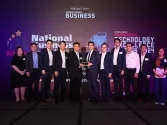
Great customer experience is a leadership commitment, says EY’s Sam Lo
Digitalisation, analytics can enable better products and services.
Sam Lo is an Assurance Partner at EY and leads a team in the firm’s private assurance practice serving emerging enterprises and private middle-market clients across Southeast Asia.
The scope of his experience includes external and internal audits of private and listed enterprises, multinationals, and government and quasi-government organisations across diverse sectors. These include manufacturing, trading, technology, retail and wholesale, investment holding, oil and gas, shipping, transportation, real estate, construction and professional services.
Lo’s wide commercial sector experience covers corporate strategy and business development, mergers and acquisitions, venture management, corporate governance, financial accounting and reporting, and risk management.
He is a fellow at the Institute of Singapore Chartered Accountants and holds a Bachelor of Accountancy (First Class Honors) from Nanyang Technological University, Singapore.
Invited by the Asian Business Review to join the Asian Experience Awards judges’ panel, Lo discusses how the pandemic has affected a sea change in the adoption of digital tools, the increasing importance of commoditising human behavioural data to enhance customer experience, and three considerations for selecting the award winners.
Which particular markets or sectors are your main focus? Can you share with us your work experience or any backstory that has contributed to your professional career?
I joined EY upon graduation with a Bachelor of Accountancy (First Class Honors) from Nanyang Technological University in 1992. After seven years, I left to join the private sector – first as a Group Financial Controller of an e-commerce organisation that provides supply chain solutions across Asia, and subsequently as President, Corporate Affairs & Services of a Singapore-listed leisure and entertainment group, which is also a family business.
I rejoined EY in 2007, bolstered by the experiences gained from the two commercial setups. These experiences gave me a better appreciation of businesses in the private market space and sets the foundation for establishing good working relationships with private business clients.
I now lead a team in EY Singapore’s assurance practice serving emerging enterprises and private businesses and family enterprise clients in Singapore and ASEAN. Private enterprises and family businesses dominate Asean and form a critical part of its economy. Despite the ongoing pandemic, Asean is still set to see stable growth in 2021 and the private business will play an active role in this growth.
The EY Private teams have bespoke services and offerings to support private businesses at every stage of their growth, including providing audits and financial close assessments; providing tax advice for those expanding into new markets or making succession plans; preparing for capital raises to spur expansions; and undertaking strategic transactions including mergers, acquisitions and exits.
How can businesses make sure that everyone is involved in delivering a great customer experience and make it more unique and seamless?
The client experience is a total experience that covers the various interactions that customers will have with various touchpoints across the entire organisation. Hence, it is important to recognise that a great customer experience does not necessarily start or end with one person or function within that organisation – instead, it is a joint effort that involves different customer-servicing teams.
The pursuit for great customer experience starts at the top and needs to be embedded into the corporate culture. This requires executive commitment, dedication from all functions and an understanding of how this approach will benefit everyone. There must also be ample agility for teams to bring differentiated experiences to their customers. When teams are misaligned in their approach to delivering a great customer experience, there is a risk of losing opportunities or customers.
If the customer experience is a vital element of the business and can impact the company’s bottom line, it is crucial to link key performance indicators to the outcomes of the organisation's efforts toward a great customer experience.
What trends are you currently seeing among businesses in terms of how they connect with customers?
The pandemic has acted as a catalyst for change, driving businesses to rethink how they operate, and how they interact with customers. This has accelerated the adoption of digital tools as companies seek alternative avenues to reach out to and engage with customers amidst lockdowns.
The pandemic has affected sectors to varying extents and this has impacted how they deliver their customer experience. For example, sectors like automotive and fast-moving consumer goods saw a drop in demand during the initial phases and had to review and transform their business operations to continue to engage with customers.
The EY Megatrends report has also highlighted the growing importance of the behavioural economy – a world in which human behaviour is a commodity that can be influenced, quantified, standardised and packaged at scale. Information about human behaviour will increasingly enable organisations to influence their customers and has perhaps never been more important than now, when the COVID-19 pandemic has driven profound shifts in consumer and citizen behaviour across everything from health care to shopping, learning and working. For example, households these days are able to compare their electricity consumption against the average consumption of their neighbours. With this comparison feature and information, the government hopes to raise customers’ awareness of their consumption pattern and hence encourage better energy-saving habits.
At the same time, companies are also making use of tools such as data analytics and artificial intelligence to provide useful insights to help their businesses to meet customers’ expectations. There will be greater use of technology moving forward that will enable companies to gain more sophisticated intelligence from their data, giving them an edge over their competitors.
In what ways can companies set themselves apart from their competition?
One effective strategy is to work on customers’ needs and requirements and seek to impress them at every opportunity. This will require companies to ensure and make improvements in the quality of their products or services. Employees must be able to go above and beyond to serve each customer.
What would be your advice to businesses that are still in the early stages of recovery?
Companies and businesses will need to relook at their digital agenda and embark on digitalisation to serve their customers. This should also take into account how their employees will deliver this service amid mobility restrictions due to the pandemic. For example, some companies are transiting from remote sales arrangements and leveraging digital solutions to reach out to customers. Automobile showrooms are going virtual as automakers and dealers look for workarounds to circumvent shuttering car dealerships and also to address increasing real estate costs and ballooning salaries. Property developers are also turning to virtual marketing as show flats are closed during lockdowns. Such initiatives allowed the outreach to overseas customers who are not able to visit in person.
In short, companies are looking into opportunities to grow amid the challenges posed by the pandemic. They need to respond swiftly, be more agile and prioritise actions to enhance business value today while building strategic resilience and capabilities to face the next crisis.
What key factors are you looking for when judging who should win?
There are three key factors I look for when judging. The first is how unique the idea, product or service is in addressing customers’ needs. As well, I look out for the use of customer feedback to develop an in-depth understanding of their customers and this includes the systems or processes they have built to collect feedback and data and analyse and act on it regularly. The last factor is the presence of innovative and creative ideas that can sustain the company in the long run.









![Cross Domain [Manu + SBR + ABF + ABR + FMCG + HBR + ]](https://cmg-qa.s3.ap-southeast-1.amazonaws.com/s3fs-public/styles/exclusive_featured_article/public/2025-01/earth-3537401_1920_4.jpg.webp?itok=WaRpTJwE)









 Advertise
Advertise


